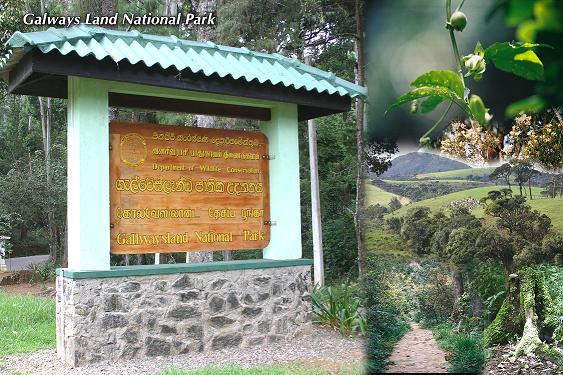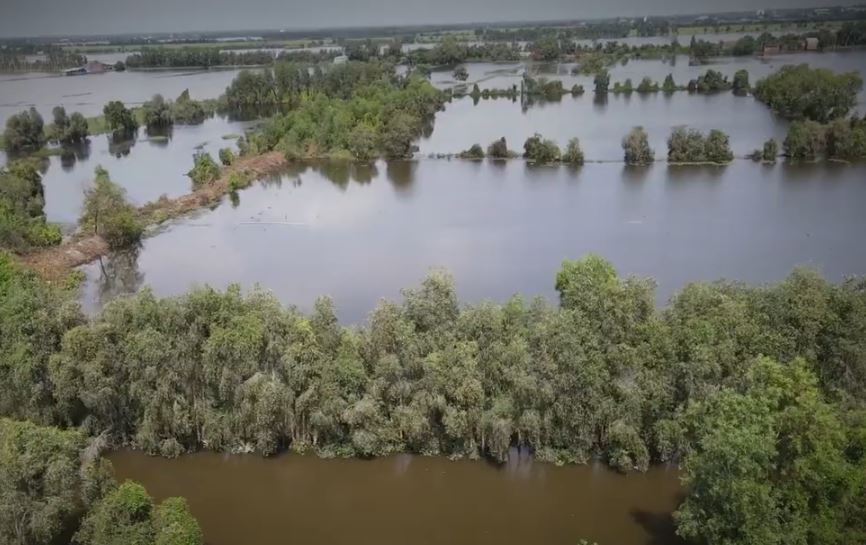Galway’s Land National Park – montane ecosystem in Nuwara Eliya
By Arundathie Abeysinghe

Situated about two kilometers from Nuwara Eliya on the outskirts of the town, Galway’s Land National Park is one of the smallest national parks in Sri Lanka with an extent of 29 hectares. Located towards east of Nuwara Eliya town, the Park is popular among people of all walks of life, yet not an overcrowded place ideal for a leisurely stroll while admiring the breathtaking scenery of the surroundings.
Galway’s Land National Park was initially declared as a wildlife sanctuary on May 27, 1938 and was declared as a national park on May 18, 2006 to conserve the montane ecosystem within the Park.
Galway’s Land National Park is named after Colonel Galway, a British Army Officer who arrived in *Ceylon in the 19th century. He was presented with the land of the Park by the British Colonia Era Government for cultivation. Colonel Galway was enthralled by the spectacular surroundings of the land as well as the natural forest with endemic fauna and flora. He decided to preserve the land without harming a single tree. When Colonel Galway left Ceylon in 1938, he requested the Governor of Ceylon with a letter to protect the land “for the sake of the unknown generations of the Ceylonese”. Hence, when the land was declared a sanctuary in 1938, it was named Galway’s Land Sanctuary.
The Park has a dense patch of montane forest comprising natural forest as well as introduced trees such as turpentine and pine trees interspersed with native flora. There are seasonal orchids as well as introduced plants with blooming flowers adding splendor to the Park. Layers of the forest floor carpeted with leaves, a haven for insects as well as microscopic fungi to larger insects and creatures, barks of gigantic trees covered with moss and lichens is a breathtaking scene which a visitor can encounter during the trek. Call of shrub frogs, perhaps communicating with each other similar to the sound of crickets amidst the litter of leaves echo rhythmically throughout the forest, especially at dusk, the tone of a musical instrument.

Popular for its exotic as well as endemic fauna and flora, the Park is frequented by environmentalists, naturalists, ornithologists, undergraduates as well as local and foreign tourists. Home to the rare winter visitor Kashmir flycatcher (Ficedula subrubra) as well as Dull blue flycatcher (Eumyias sordida) and Grey headed flycatcher (Culicicapa ceylonensis), there are over 30 endemic and exotic birds in the Park. Popular as a Birders’ Paradise as well as a haven for feathered creatures, according to ornithologists, Galway’s Land National Park is a significant birding site because of the high density of birds in the Park.
Apart from birds, the Park is home to many species of multi-colored butterflies as well as bees busy with pollination tasks, a mesmerizing site.
There are 10 endemic Sri Lankan birds and about 20 rare migrant birds in the Park, on their way in search of food or returning to their nests while many are nesting and feeding their young. There are also transient fowl species in the Park.
Apart from birds, the Park is also home to a large number of mammals such as barking deer (Muntiacus), wild boar (Sus scrofa) and wild water buffalo (Bubalus arnee) coexisting to form biodiversity. Apart from these mammals, horned lizard (Ceratophora stodartii) and earth snakes, especially the common rough side snake (Aspidura trachyprocta), the only type of snakes endemic in hilly terrains are also found in the Park.
The Park is also home to endemic dusky-striped jungle squirrel (Funambulus obscurus) and rare day gecko (Phelsuma), an endangered species. Jungle fowls (Gallus), giant squirrels (Ratufa macroura) and highland bear monkeys (Semnopithecus vetulus) have also made the Park a safe haven.
The atmosphere of the Park is filled with the aroma and beauty of wild flowers as well as planted flowers landscaped in a breathtaking manner. The wooden benches in the Park are ideal for those who want to relax while walking or bask in the glory of the spectacular surroundings.
There are two trails in the Park and the first trail is a distance of around 850 meters situated to the left side of the Park and after climbing a few steps leads towards the forest area. As the terrain has gentle slopes, the trail is easy to trek. The second trail, one kilometer distance trek continues after the first trail with mesmerizing views of fauna and flora.
Although, the Park can be visited without a guide as the trek is easy to follow, if there is any necessity for a guide, the Park Officers are ready to assist visitors.
The Park is open for visitors from 6.00 a.m. to 5.00 p.m.
At present, the Park is conserved by the Department of Wildlife Conservation.
Location: Department of Wildlife Conservation, Havelock Road, Nuwara Eliya.
Directions: From Nuwara Eliya travel along Upper Lake Road to Havelock Road to reach the Park.
- Ceylon – Sri Lanka was known as Ceylon until 1972.
Image courtesy: dwc.gov.lk





















